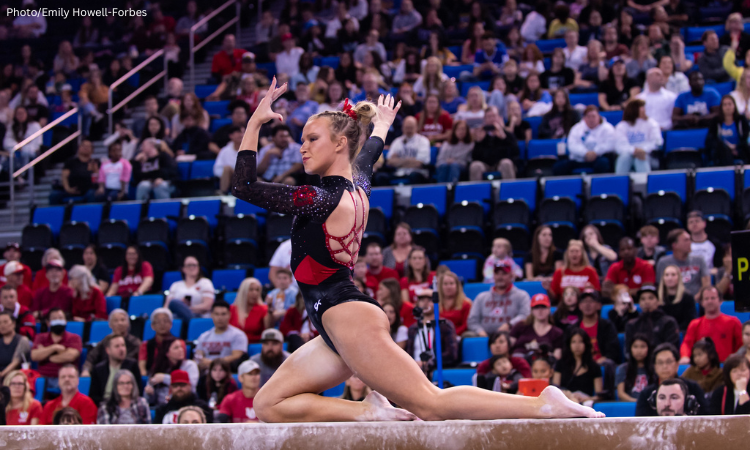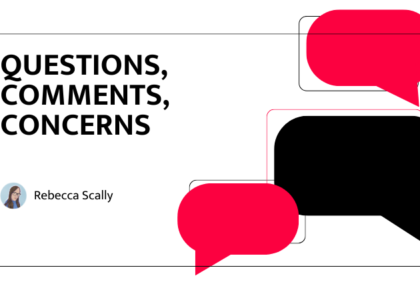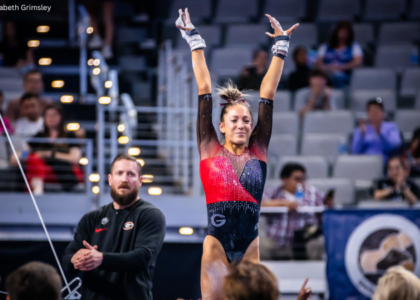The aroma of freshly popped popcorn mixed with hairspray and self-tanner consumes the air of LSU’s Pete Maravich Assembly Center, affectionately called the PMAC. The lights shine bright, the thousands of fans start to fill the arena, and the adrenaline starts to build. Going up to the first event, KJ Johnson notices her heart beating faster, her body tensing up, and her nerves elevating. That is the moment when it clicks that it is competition time, and what happens on the apparatus is going to be scored. In that moment before saluting, the noise produced by the crowd injects a shot of adrenaline into the competitor, helping each gymnast to compete at their best. It might not be the most expected in such an individual sport, but the crowd influences the performances in competition.
These crowds come in all shapes and sizes, and they all have influences on the experience of the gymnasts on the competition floor. Utah consistently boasts some of the highest attendance numbers for gymnastics meets, if not the highest. You can expect to see 15,000 fans in attendance at Utah home meets, with the attendees at LSU following close behind. The environments produced by schools, especially those in the SEC, are noted by gymnasts around the country. Is bigger always better? How much do the gymnasts notice the competition environment? What do gymnasts want to see from the crowd?
A common sentiment is that gymnasts do not just notice the crowd, but they want it. N.C. State fifth–year Alexis Ortega mentioned that those new to gymnastics meets are surprised when she tells them that the gymnasts want both the audience and the noise. Competing in front of a large audience gives a gymnast a boost of adrenaline that is what competing is all about. When describing how the energy affects her performance she said, “I think energy is one of those things where it just carries you, like you can just kind of like transcend these boundaries that you didn’t even know.”
With the crowds being so variable week in and week out, some gymnasts choose to block out whatever the crowd is doing while competing. Gabby Wilson is one such gymnast. Wilson explained, “When I’m competing, I kind of block everything out.” She hears the occasional cheers from teammates but does not notice the crowd until she salutes. Her appreciation of the crowd comes when she is watching her teammates compete, as well as after the meet when she looks up the video of her own floor routine to see how the crowd was interacting with it.
For other gymnasts, like Abby Paulson, how much they feel the crowd depends on the event. On floor, the noise from the crowd adds to her adrenaline in a way that helps to improve her performance. That experience is different on her pet event, beam, where Paulson tends to stay in her own bubble. She hones in on her beam song, and sometimes, the crowd joins her. When Paulson competed at LSU a couple of seasons back, the crowd started to sing along to her Taylor Swift beam song. She was not sure if it was meant to throw her off, but she loved it and went on to stick her dismount.
While competing in front of a home crowd has that special feeling of knowing that the audience is there to cheer you on, the audience affects the away team as well. While gymnasts try to stay in their own team bubble, a loud away crowd adds to the adrenaline of the away team in a similar way. When the crowd is loud, or when the away fans travel, gymnasts can use that energy produced from the cheers to fuel them whether the cheers are meant for them or not. Gymnasts want crowd interaction during the competition, and they want the cheering to be for both teams. Paulson loves that the fans at Utah are fans of gymnastics and are good about cheering for great gymnastics no matter who produces it, and Wilson echoes this sentiment at Michigan.
When asking gymnasts what their memorable away audience experiences have been, Auburn came up frequently. Auburn is known for having the student group the Gymnasties in the front row of the student section by the floor. The arena is already full and loud, but many gymnasts still notice the students trying to imitate the floor choreography of away competitors. Aleah Finnegan described the environment as being fun to compete in as an away competitor, even if it was a little hostile because the fans were so invested.
Auburn was also a memorable audience for Johnson. She recalled her floor routine from Auburn, “When they were trying to mock the way I did my starting pose, I had a part of my routine right before my first pass where I turned to them and gave them a little head nod or whatever. And then I went and, you know, killed the first pass. And it was kind of just a way to shut them up you know?”
Ortega has regularly competed at ACC and EAGL schools, which tend to have smaller audiences compared to those in the SEC. After competing at Auburn in the 2023 season, her team recognized the type of audience it was trying to bring to N.C. State, namely the large student section:
“What we’ve been working on and getting this idea of a big student section to kind of come together and we saw that come to fruition a little bit at the end of last season,” said Ortega “So I think just building upon that and kind of encouraging our fans to get more involved, like I said earlier. I think people don’t recognize how much we actually enjoy it and how fun and exciting it makes [the meet], so I think just kind of emphasizing that we want to interact with you, we want the noise, we want the fun.”
Gymnasts want to feel the adrenaline that an invested crowd enhances and grows whether that be at home or on the road. Those meets with loud crowds, that cheer for good gymnastics, make for the best audiences in college gymnastics. Go to a meet, participate in the crowd activities, and cheer on both teams. Ortega said, “We love sharing our environment with people… bring your energy, bring your intrigue to it, and we love to perform for everybody.”
READ THIS NEXT: Data Deep Dive: Comparing Team Distance Traveled
Article by Alyssa Van Auker





12 comments